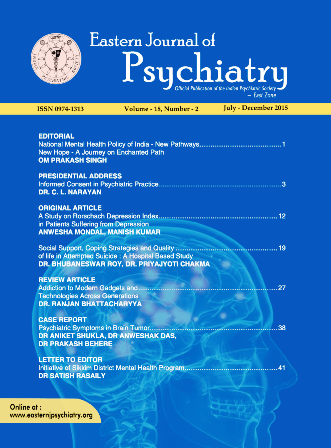Social Support, Coping Strategies and Quality of Life in Attempted Suicide : A Hospital Based Study
Abstract
Background: There is a major concern all over the world regarding the rise in attempting suicide in certain population especially among the young. Wide variations have been found in suicidal attempt among different cultures, societies and countries. The rate of attempted suicide is 8-10 times more than the completed suicide. Coping is most often conceptualized as a response to the demands of specific stressful situations. Though deliberate self‑harm encompasses a wide variety of medical and social disciplines some of the important psychosocial variable such as social support, coping strategies, and quality of life has not yet been explored in depth in India.
Aims: The aim was to analyze and compare the coping strategies, social support, and quality of life of suicide attempters versus matched normal controls, and to identify the risk factors leading to suicide.
Settings and Design: The study was conducted in the Department of Psychiatry, Agartala Govt. Medical College & GBP Hospital, Agartala, Tripura. The samples for the study were recruited from different outpatient & indoor facilities of the GBP Hospital after application of the inclusion and exclusion criteria (n = 100) cases of suicide attempters and healthy controls (n = 100) were included in the study.
Materials and Methods : A total of 100 consecutive suicide attempters were compared with same number of age, sex, and marital status matched healthy controls using Social Support Questionnaire, Bengali version of ways of coping Quissionare (Susan Folkman and Richard S. Lazarus) and WHO QOL‑Bref. Statistical analysis was done by using SPSS - 20.
Results : Attempters experienced significantly less Social support. Most common Coping strategies used by the suicide attempters were confronting coping (72.5%) followed by distancing (60%) and predominant coping strategies used by the control groups were seeking social support (60%), accepting responsibility (52) and self-controlling (45%). Positive coping, and of QOL were significantly lower in attempters. Among all risk factors good education and good social support were protective against suicide.
Conclusion : Suicide attempters were differentiated from healthy controls basedon lower social support, less healthy coping, and poor QOL. However, it is difficult to pinpoint a single factor responsible for suicidal behavior. It is the complex interplay of various interrelated factors and the resultant buffering effect, which is protecting the individual against deliberate self‑harm.
Key words : Coping strategies, deliberate self-harm, quality of life, social support.

